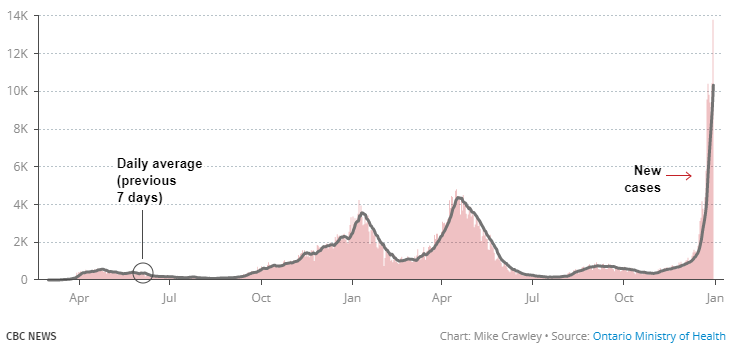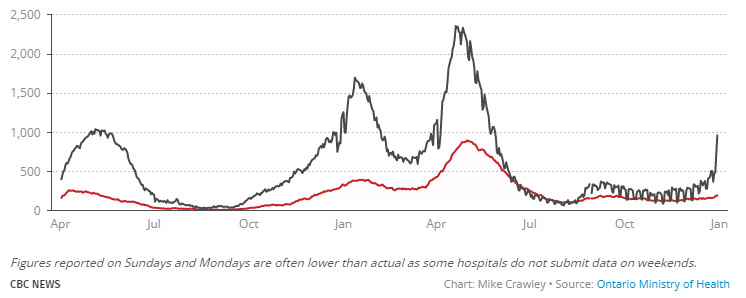- Your cart is empty
- Continue Shopping
Ontario logs 13,807 new COVID-19 cases ahead of announcement from chief medical officer of health

Dr. Kieran Moore scheduled to hold 3 p.m. ET news conference

Ontario reported a pandemic high of 13,807 new cases of COVID-19 on Thursday — far outpacing the previous record set on Wednesday and ahead of an expected announcement from the province’s chief medical officer of health.
Infectious disease experts have said the actual number of new cases is likely far higher than those reported each day because many public health units in Ontario have reached their testing capacity.
The seven-day average of daily cases has topped 10,000 for the first time in the province, and now stands at 10,328. It is on pace to double every five days or so.
Positivity rates similarly continued to spike. Public Health Ontario logged a 30.5 per cent positivity rate Thursday on 67,301 tests, the highest level ever seen in the province. The previous three days saw rates of 26.9, 24.9 and 24.5 per cent, respectively.
Ontario: New daily cases of COVID-19
The dark grey line is the average daily number of new cases over the previous seven days

As of Wednesday evening, there were 96,455 test samples in the backlog waiting to be completed — also a new pandemic high.
The number of patients with COVID-19 in hospitals climbed to 965, up from 726 on Wednesday and 440 at the same time last week.
There were also 200 people being treated for COVID-related illnesses in intensive care units, up from 169 last Thursday.
COVID-19 patients in Ontario hospitals and ICUs
The number of people with COVID-19 in hospital each day includes the number in intensive care.
Patients with COVID-19 in hospital – Patients with COVID-19 in intensive care

Minister of Health Christine Elliott said the province is working with hospitals to distinguish between patients admitted to hospitals and critical care because of COVID-19 and those who test positive while in care for other reasons. Daily data will soon reflect that distinction, she said.
The Health Ministry recorded the deaths of eight more people with the illness, pushing the official toll to 10,179.
Meanwhile, Chief Medical Officer of Health Dr. Kieran Moore is set to hold a 3 p.m. ET news conference after the province said recently it would make changes to COVID-19 case and contact management protocols and testing guidance.
It also comes as families wait to hear whether students will be returning to class in-person on Monday amid a continuing wave of COVID-19 cases caused by the Omicron variant.
You’ll be able to watch the announcement live in this story.
Moore was supposed to hold a news conference on Tuesday, but it was postponed after U.S health officials cut isolation times for COVID-positive Americans from 10 to five days, and similarly shortened the time that close contacts need to quarantine.
Officials at the U.S. Centers for Disease Control and Prevention (CDC) said the guidance was in keeping with growing evidence that people with the coronavirus are most infectious in the two days before and three days after symptoms develop.
Like Ontario, many areas in the U.S. are experiencing dramatic increases in new COVID-19 cases. While early research suggests Omicron may cause less severe illness than previous variants, the sheer number of people becoming infected — and therefore having to isolate or quarantine — threatens to crush the ability of U.S. hospitals, airlines and other businesses to stay open, the CDC said.
The Ontario Ministry of Health said Moore wanted time to review the U.S. changes before announcing any revised policies for the province.
Omicron less likely to result in hospitalization or death: PHO
A new study from Public Health Ontario suggests that Omicron is indeed less likely to lead to hospitalization or death than the Delta variant, which drove the third wave in the province.
The agency identified 6,314 Omicron cases that saw symptoms emerge between Nov. 22 and Dec. 17, and matched them with Delta cases based on age, gender and onset date.
It found that after adjusting for vaccination status and region, the risk of hospitalization or death was 54 per cent lower in Omicron cases than Delta cases.
“Omicron appears to be the first dominant variant to demonstrate a decline in disease severity,” the study said.
While severity may be reduced, due to the transmissibility of Omicron, the absolute number of hospitalizations and impact on the healthcare system is likely to be significant.”
WATCH | Ontario parents anxious about back-to-school plans:








